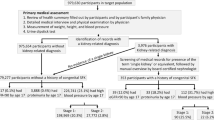Abstract
In patients with a single functioning kidney, renal function was assessed at regular intervals over a period of 10 years. Serum creatinine, glomerular filtration rate (GFR), blood pressure, and urinary protein–creatinine ratio were assessed at the age of 2, 5 and 10 years. Between January 1980 and December 2005, 99 such patients were diagnosed in the first year of life. They were divided into three groups: A, patients with multicystic kidney disease and a normal contralateral kidney (n = 36); B, patients with a normal solitary kidney without uropathy (n = 20); and C, patients with obstructive uropathy and one nonfunctioning kidney (n = 43). Serum creatinine levels increased significantly with increasing age in every group. In group C, serum creatinine was significantly elevated compared with group A in all age categories (p = 0.043, p = 0.019, p = 0.001 respectively). Median figures of GFR remained within normal limits over the 10-year period. GFR was significantly lower in group C compared with group A (p = 0.001, p = 0.009, p = 0.019 respectively) and B in all age categories (p = 0.013, p = 0.002, p = 0.016 respectively). There were no changes in blood pressure over time and no differences among the three groups were observed. At the age of 10 years, the patients in group C had a significantly higher median urinary protein–creatinine ratio (p = 0.022) than those in groups A and B. There was also an increasing level of proteinuria with increasing age in group C (p = 0.002). In conclusion, renal function was stable over time in all patients, but children with obstructive uropathy have a lower median GFR and higher serum creatinine level for the whole study period. Hypertension was exceptionally observed in group C, with obstructive uropathy, as was an elevated urinary protein–creatinine ratio.

Similar content being viewed by others
Abbreviations
- ABPM:
-
ambulatory blood pressure measurement
- GFR:
-
glomerular filtration rate
- MCKD:
-
multicystic kidney disease
- Up/c:
-
urinary protein–creatinine ratio
- UPJO:
-
ureteropelvic junction obstruction
- UVJO:
-
ureterovesical junction obstruction
- VUR:
-
vesico-ureteral reflux
References
Anonymous (1987) Report of the second task force on blood pressure control in children. Pediatrics 79:1–25
Argueso LR, Ritchey ML, Boyle ET Jr, Milliner DS, Bergstralh EJ, Kramer SA (1992) Prognosis of children with solitary kidney after unilateral nephrectomy. J Urol 148:747–751
Argueso LR, Ritchey ML, Boyle ET Jr, Milliner DS, Bergstralh EJ, Kramer SA (1992) Prognosis of patients with unilateral agenesis. Pediatr Nephrol 6:412–416
Aslam M, Watson AR (2006) Unilateral multicystic dysplastic kidney: long term outcomes. Arch Dis Child 91:820–823
Baudoin P, Provoost AP, Molenaar JC (1993) Renal function up to 50 years after unilateral nephrectomy in childhood. Am J Kidney Dis 21:603–611
Brenner BM, Lawler EV, Mackenzie HS (1996) The hyperfiltration theory: a paradigm shift in nephrology. Kidney Int 49:1774–1777
Douglas-Denton R, Moritz KM, Bertram JF, Wintour EM (2002) Compensatory renal growth after unilateral nephrectomy in the ovine fetus. J Am Soc Nephrol 13:406–410
Glazebrook K, McGrath F, Steele BT (1993) Prenatal compensatory renal growth: documentation with US. Radiology 189:733–735
Heymans C, Breysem L, Proesmans W (1998) Multicystic kidney dysplasia: a prospective study on the natural history of the affected and contralateral kidney. Eur J Pediatr 156:673–675
Higashihara E, Horie S, Takeuchi T, Nutahara K, Aso Y (1990) Long term consequence of nephrectomy. J Urol 143:239–243
Kuwertz-Broeking E, Brinkmann OA, Von Lengerke HJ, Sciuk J, Fruend S, Bulla M, Harms E, Hertle L (2004) Unilateral multicystic dysplastic kidney: experience in children. BJU Int 93:388–392
Maluf NS (1997) On the enlargement of the normal congenitally solitary kidney. Br J Urol 79:836–841
Mei-Zahav M, Korzets Z, Cohen I, Kessler O, Rathaus V, Wolach B, Pomeranz A (2001) Ambulatory blood pressure monitoring in children with a solitary kidney—a comparison between unilateral renal agenesis and uninephrectomy. Blood Press Monit 6:263–267
Robitaille P, Lortie L, Mongeau JG, Sinnassamy P (1985) Long-term follow-up of patients who underwent unilateral nephrectomy in childhood. Lancet 8:1297–1299
Seeman T, Patzer L, John U, Dusek J, Vondrak K, Janda J, Misselwitz J (2006) Blood pressure, renal function, and proteinuria in children with unilateral renal agenesis. Kidney Blood Press Res 29:210–215
Wikstad I, Celsi G, Larssoon L, Herin P, Aperia A (1988) Kidney function in adults born with unilateral renal agenesis or nephrectomized in childhood. Pediatr Nephrol 2:177–182
Williams SL, Oler J, Jorkasky DK (1986) Long-term renal function in kidney donors: a comparison of donors and their siblings. Ann Intern Med 105:1–8
Wilson BE, Davie P, Shah K, Wong W, Taylor CM (2003) Renal length and inulin clearance in the radiologically normal single kidney. Pediatr Nephrol 18:1147–1151
Author information
Authors and Affiliations
Corresponding author
Rights and permissions
About this article
Cite this article
Vu, KH., Van Dyck, M., Daniels, H. et al. Renal outcome of children with one functioning kidney from birth. A study of 99 patients and a review of the literature. Eur J Pediatr 167, 885–890 (2008). https://doi.org/10.1007/s00431-007-0612-y
Received:
Revised:
Accepted:
Published:
Issue Date:
DOI: https://doi.org/10.1007/s00431-007-0612-y




